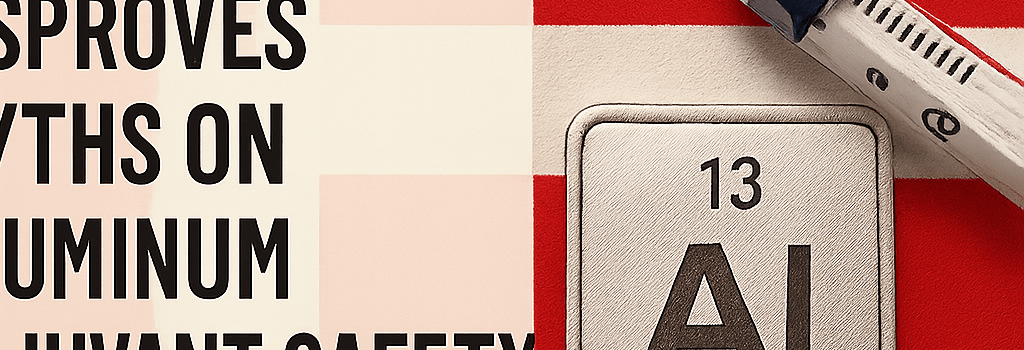Danish Study Disproves Myths on Aluminum Adjuvant Safety

Updated: July 15, 2025
Introduction
A new large-scale pharmacoepidemiological analysis of more than 1.2 million Danish children born between 1997 and 2018 has reaffirmed the long-standing safety profile of aluminum-based adjuvants in routine childhood vaccines. Published in the Annals of Internal Medicine, the study finds zero statistically significant links between cumulative aluminum exposure and over 50 chronic conditions, including neurodevelopmental disorders such as autism spectrum disorder (ASD) and attention-deficit/hyperactivity disorder (ADHD).
Background: Aluminum in Vaccines
“Aluminum salts have enhanced the immunogenicity of inactivated and subunit vaccines for nearly 90 years without credible evidence of harm,” says Dr. Maria Sørensen, immunologist at Statens Serum Institut.
Aluminum adjuvants—primarily aluminum hydroxide, aluminum phosphate, and aluminum potassium sulfate—act by creating a depot at the injection site, promoting antigen uptake by dendritic cells and stimulating innate pathways such as the NLRP3 inflammasome. These materials augment the magnitude and durability of antibody and T-cell responses. They are key components in vaccines against diphtheria, tetanus, pertussis (DTaP), hepatitis A/B, and Haemophilus influenzae type b (Hib).
Study Design and Methods
- Data source: Denmark’s centralized national health registry, encompassing vaccination records and diagnostic codes.
- Cohort: 1 238 829 children, birth years 1997–2018, followed through age 10 for health outcomes.
- Exposure metric: Cumulative aluminum adjuvant dose per child (0 mg to 4.5 mg by age 2), calculated using batch-specific aluminum content.
- Endpoints: Fifty chronic conditions spanning autoimmune, allergic, atopic, and neurodevelopmental domains.
- Statistical analysis: Cox proportional hazards models, adjusting for sex, birth cohort, maternal health, socioeconomic status, and urban/rural residence.
Key Findings
- No significant association (p>0.05) between aluminum exposure and increased risk of asthma, eczema, food allergies, or allergic rhinitis.
- No elevated hazards for ASD or ADHD across aluminum dose quintiles (hazard ratio [HR]≈1.00, 95% CI 0.96–1.04).
- Analyses had sufficient power (>90%) to detect relative risk increases of 10% or greater for common conditions; for rare conditions, small (<2%) risk elevations could not be entirely excluded but lacked clinical relevance.
“These comprehensive data dispel any plausible link between aluminum adjuvants and chronic pediatric diseases,” remarks lead author Dr. Niklas Worm Andersson.
Immunological Mechanisms of Aluminum Adjuvants
At the molecular level, aluminum adjuvants form nanoparticle aggregates that trigger localized inflammation and recruit antigen-presenting cells (APCs). In vitro studies demonstrate that aluminum crystals activate the NLRP3 inflammasome, leading to IL-1β secretion and enhanced CD4+ T-helper cell priming. Recent cryo-EM analyses by the Vaccine Research Center (VRC) at NIH elucidate how aluminum–antigen complexes stabilize tertiary protein structures, preserving conformational epitopes critical for neutralizing-antibody generation.
Advanced Pharmacoepidemiological Insights
Beyond standard registry analyses, the study employed negative-control outcomes and self-controlled case series (SCCS) to mitigate unmeasured confounding. Real-world evidence (RWE) approaches, including high-dimensional propensity score (HDPS) adjustment, validated primary findings. Data linkage with the Danish Biobank allowed genotypic stratification, confirming no gene–environment interactions between aluminum exposure and polymorphisms in immune-regulatory loci (e.g., IL-6, TNF).
Policy Implications and Future Directions
Despite unequivocal evidence, anti-vaccine advocates, led by U.S. Health Secretary Robert F. Kennedy Jr., continue to press for an Advisory Committee on Immunization Practices (ACIP) review of aluminum adjuvants. At the June 2025 ACIP meeting, members lacking vaccine-development expertise voted to remove thimerosal-containing influenza vaccine recommendations. Should a similar motion target aluminum adjuvants, over two dozen vaccines in the U.S. immunization schedule could face coverage disruptions.
Global health authorities, including the World Health Organization’s Global Advisory Committee on Vaccine Safety (GACVS), have reviewed aluminum adjuvant datasets repeatedly, concluding no safety concerns. Manufacturers such as GlaxoSmithKline and Sanofi are advancing next-generation adjuvants—e.g., CpG 1018, AS01B—for specialized vaccines, but aluminum salts remain the backbone for routine immunization programs worldwide.
Expert Perspectives
- Dr. Rino Rappuoli, Novartis Vaccines: “Aluminum adjuvants have unparalleled safety and scalability, especially in low-resource settings.”
- Dr. Kate O’Brien, WHO Vaccines Department: “The new Danish study reinforces the decades of safety data and should guide policy away from unscientific reviews.”
- Dr. Paul Offit, Children’s Hospital of Philadelphia: “Misconceptions about aluminum drive vaccine hesitancy more than any other single factor.”
Conclusion
This exhaustive Danish registry study, underpinned by robust statistical and immunological data, puts to rest lingering myths about aluminum adjuvant toxicity. As policymakers and public health agencies navigate the evolving vaccine ecosystem, adherence to evidence-based recommendations remains essential to safeguard population health and maintain public confidence in immunization programs.